Funnish is a completely original writing system designed in 2011 by Sheldon Ebbeler, a linguist and analyst of verbal behavior. It was created to explore a unique philosophy of writing. That is, the terms "alphabet," "syllabary," and so on, which involve lumping together simultaneous features of sound, do not apply. By contrast, Funnish represents sequential features of sound. This new type of writing system (for which Funnish is the first example) is herein termed a Mananone. The term "Mananone" arose in the spirit of how other writing systems have been named. As "alphabet" is derived from the names of the first two letters of the Greek alphabet, and as "Futhark" came from the initial sounds the first six rune names, "Mananone" stems from the names of the first graphemes of the Funnish Mananone. Incidentally, the word "mananone" translates very loosely to "Hell, yes."

Sounds within any given spoken language are not totally dissimilar from each other. Rather, sounds relate to one another by sharing distinctive features. Distinctive features are properties or aspects of phonemes that allow us to describe and identify that sound in a more systematic and detailed fashion. For example, the sounds [p] and [m] share the distinctive feature value of labial place, referring to the fact that they are both produced with the lips. The sounds [p] and [t], on the other hand, are both stop sounds. This stems from fact that airstream must stop with a complete closure somewhere in the mouth. In general, there are at least two distinctive feature types that must be identified to specify a given sound for a language: place and closure. Closure is the distinctive feature type that relates how the areas of the mouth and vocal tract are closed and the extent of that closure. (NOTE: I use the term "closure" here to encompass the traditional term "manner." The reason for this becomes more obvious when we discuss vowels.) Place, on the other hand, is the distinctive feature type that specifies exactly where in mouth the sound is being made. (There is a third distinctive feature type, voicing, which is typically discussed, but we will address this later.)
Here are the minimal phonologies for Finnish and Estonian. These charts identify the values for these two distinctive feature types (place and closure) for each sound of each language. The graphemes shown here illustrate how the Latin alphabet has been used to represent the sounds of these two languages.
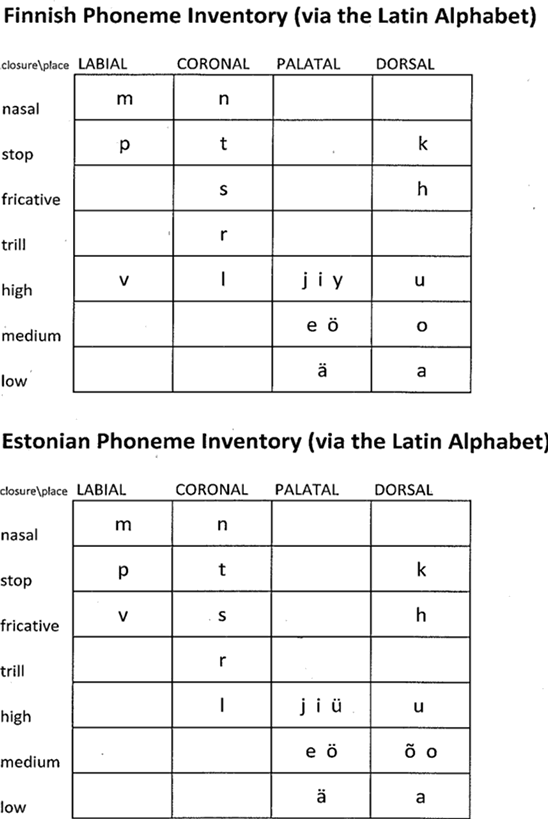
Here are some significant points about these alphabets:
Conventional writing systems that represent spoken sounds of a language (like alphabets and even syllabaries) combine simultaneous features of sounds. For alphabets, this yields the familiar segment graphemes of a language, i.e, its written letters. (See the charts above for the traditional Finnish and Estonian alphabets.) For syllabaries, multiple segments are combined into syllabograms. The diagram below shows how simultaneous spoken features can be coded by multiple letters (in this case, using the Latin alphabet) or a single syllabogram (using the Cherokee syllabary, in this example).
![Syllable [se] in Funnish](../images/writing/funnish03.gif)
A mananone is a completely unconventional writing system. Instead of combining simultaneous features, a mananone combines sequential features. Here is the same syllable captured with the Funnish mananone.
With alphabets, the two main types of letters are consonant graphemes and vowel graphemes. Each of an alphabet's graphemes represents the combination of that sound's simultaneous closure and place values.
In contrast, with a mananone, the two types of component graphemes are place graphemes and closure graphemes. Each of a mananone's graphemes represents the combination of two sequential closure values (for closure graphemes) or two sequential place values (for place graphemes). Below are the Funnish mananone's two sets of written symbols:
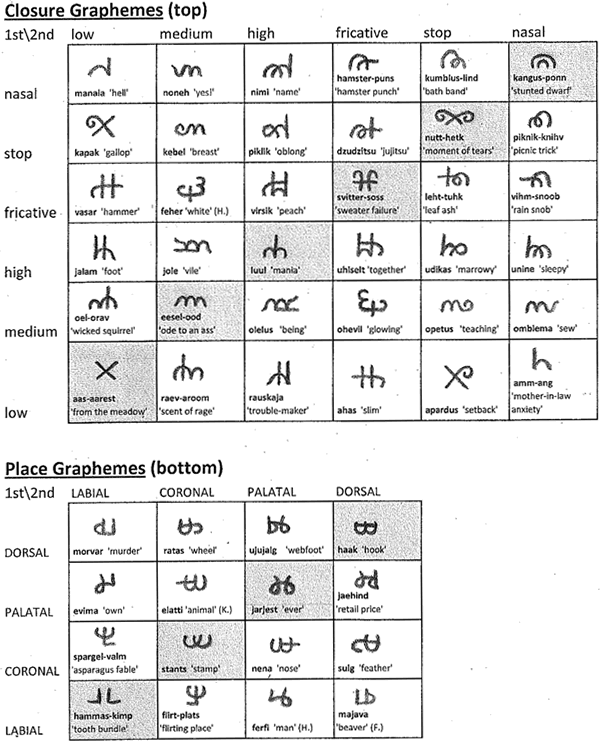
Notice that each of the individual Funnish graphemes consists of a monogram of the first initial letters of the two sequential place values or closure values for that pair of sounds. Therefore, for example, the closure grapheme for "fricative" + "mid" is a monogram of f + m. This pattern was modeled after the fanciful monogrammed letters after z as envisioned by Theodor Geisel (AKA "Dr. Seuss") in his children's book On Beyond Zebra. The pattern assists in memorization of the symbols. However, the symbols themselves cannot be decomposed into individual feature values. For example, the f in the fricative+mid monogram is distinct from the f in the fricative+nasal monogram. (Thus, Funnish is not strictly featural, like Hangul.)
Another aid to memorization is the specific arrangement of each monogram. Namely, an inverse of any given sequence is represented by the mirror image of that sister monogram. So, for example, the mid+fricative grapheme is simply the reflection of the fricative+mid grapheme. This cuts in half the number of symbols to be learned. Not surprisingly, when the two sequential place or closure values are the same (e.g, fricative+fricative), the grapheme is symmetrical about the midline.
The symbols are named not based on what they look like. Rather, a word that is written using two of that particular symbol serves as that symbol's name. (That is, for instance, the Estonian word for "wheel" is "ratas." It is written in Funnish using two of the Dorsal-Coronal graphemes. Therefore, "Ratas" is an appropriate name for the Dorsal-Coronal symbol.) When a common word fitting this criterion was not readily available, a compound-often nonsensical-was created to name that symbol. (For example, one particular symbol happens to be named "wicked squirrel.") The letter names are all derived from Estonian words unless otherwise noted (i.e, H. = 'Hungarian,' F. = 'Finnish').
Finnish and Estonian often make distinctions that are not written using the standard alphabet. With Estonian, for example, palatalization occurs before front vowels, though this is unseen within the orthography. With Finnish, initial consonants geminate at morpheme boundaries. Generally, a nasal undergoes place assimilation before a velar consonant (i.e, [n] à [ŋ]), though this is not written. Other effects (e.g, Sandhi effects) are predictable in a similar fashion. Such alterations in sounds not indicated with the standard writing need not be represented when using Funnish either.
There are, however, situations for which added detail would be preferable. In particular, when a contrast occurs that might result in ambiguity, otherwise optional symbols should be used for further clarity.

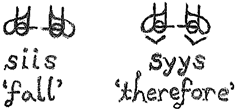
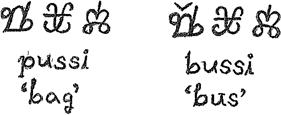
One sound common to both languages that does not fit within the Funnish grid of phonemes is the trill [r]. This sound is exceptional with Funnish in that it is represented segmentally via a non-optional diacritic. When a trill occurs between conjuncts, a carat symbol occurs between the conjuncts. When a trill occurs within a conjunct, this carat occurs above the conjunct. Note that this diacritic resembles a simplified, rotated r.

There are several aspects of a mananone that do not make it the most practical of writing systems. For one thing, it is not uncommon for things in close temporal or physical proximity to each other to be identified with each other. Thus, it is certainly much more natural for speakers of a given language to perceive simultaneous features together as a unit (i.e, segmentally), rather than sequential features. It is not surprising then that alphabets have naturally arisen over mananones. Second, the general inability to represent words with an odd number of phonemes elegantly is an obvious drawback. Finally, for a mananone to be at all practical, most sounds should fall within and fill up a 2-dimensional grid of sounds. This is why Finnish and Estonian are close to ideal candidates for this type of writing system. However, a mananone would not be an efficient means to represent most languages' phonologies. So, in general, while a mananone might not be a viable alternative for a more standard alphabet, its consideration has been fun nonetheless - or at least, funnish.
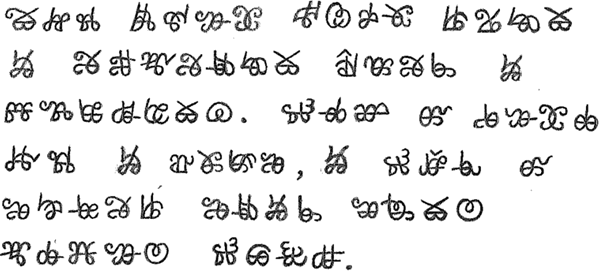
Kaikki ihmiset syntyvät vapaina ja tasavertaisina arvoltaan ja oikeuksiltaan. Heille on annettu järki ja omatunto, ja heidän on toimittava toisiaan kohtaan veljeyden hengessä.
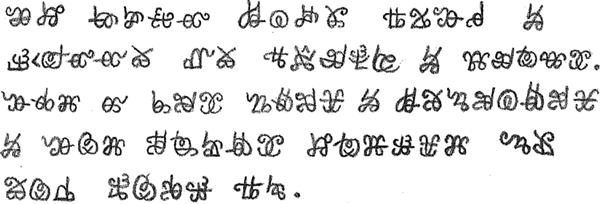
Kõik inimesed sünnivad vabadena ja võrdsetena oma väärikuselt ja õigustelt. Neile on antud mõistus ja südametunnistus ja nende suhtumist üksteisesse peab kandma vendluse vaim.
All human beings are born free and equal in dignity and rights. They are
endowed with reason and conscience and should act towards one another in
a spirit of brotherhood.
(Article 1 of the Universal Declaration of Human Rights)
For more information about Funnish, please contact Sheldon Ebbeler at sheldonebbeler[at]yahoo[dot]com
Funnish, Knot alphabet, Tengwarpt, Uriovakiro
Constructed scripts for: Ainu | Arabic | Chinese languages | Dutch | English | Hawaiian | Hungarian | Japanese | Korean | Lingala | Malay & Indonesian | Persian | Tagalog / Filipino | Russian | Sanskrit | Spanish | Taino | Turkish | Vietnamese | Welsh | Other natural languages | Colour-based scripts | Tactile scripts | Phonetic/universal scripts | Constructed scripts for constructed languages | Adaptations of existing alphabets | Fictional alphabets | Magical alphabets | A-Z index | How to submit a constructed script
[top]
You can support this site by Buying Me A Coffee, and if you like what you see on this page, you can use the buttons below to share it with people you know.

If you like this site and find it useful, you can support it by making a donation via PayPal or Patreon, or by contributing in other ways. Omniglot is how I make my living.
Note: all links on this site to Amazon.com, Amazon.co.uk
and Amazon.fr
are affiliate links. This means I earn a commission if you click on any of them and buy something. So by clicking on these links you can help to support this site.
[top]